Fault Code 15: HIL Shift Device Communication
J1587: MID 130 SID 18 FMI 9
J1939: SA 3 SPN 751 FMI 9
Overview
Vehicles equipped with an UltraShift PLUS transmission may also have an Eaton Push Button Shift Control Device (PBSC). The PBSC broadcasts driver shift requests to the Transmission Electronic Control Unit (TECU) through a high speed proprietary data link called the High Integrity Link (HIL). The portion of the HIL that connects the TECU to the PBSC is contained within the 38-Way Vehicle Harness. The Electronic Clutch Actuator (ECA) communicates to the TECU through a portion of the HIL contained in the Transmission Harness. Fault Code 15 indicates a loss of communication between the TECU and PBSC.
Detection
The TECU monitors communication with the PBSC over the HIL. If the TECU loses communication with the PBSC, Fault Code 15 sets Active.
Conditions to Set Fault Code Active
FMI 9 – Abnormal Update Rate: TECU loses communication with the PBSC for 5 seconds or longer, but can still communicate with the ECA.
Fallback
FMI 9
- “F” flashes in gear display.
- Service light flashes (if equipped).
- Transmission may not engage a gear from neutral.
- Transmission is limited to down shifts only.
- Once the transmission re-engages the start gear, the transmission will not shift until the fault becomes Inactive.
- Once the vehicle stops, the transmission will not engage a start gear until the fault becomes Inactive.
Conditions to Set Fault Code Inactive
FMI 9: The TECU establishes communication with the PBSC for 10 seconds.
Possible Causes
FMI 9
- High Integrity Link (HIL)
- Wiring shorted to ground, shorted to power or open
- Bent, spread, corroded or loose terminals
- Missing or additional terminating resistors
- 38-Way Vehicle Harness Connector
- Wiring shorted to ground, shorted to power or open
- Bent, spread, corroded or loose terminals
- Vehicle Power and Ground Supply to PBSC
- Poor power or ground supply to PBSC
- Bent, spread, corroded or loose terminals
- Wiring shorted to ground, shorted to power or open
- PBSC
- Internal failure
- TECU
- Internal failure
Component Identification
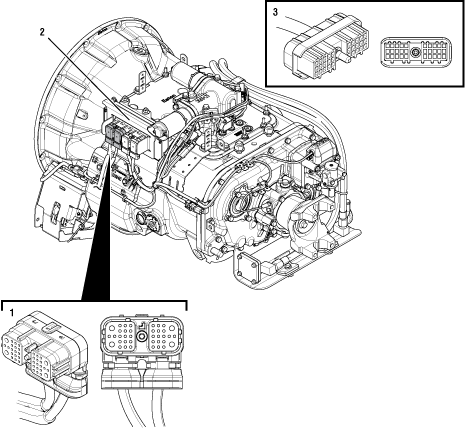 |
1. 38-Way Vehicle Harness Connector 2. Transmission Electronic Control Unit (TECU) 3. 30-Way Push Button Shift Control Device (PBSC) Connector |
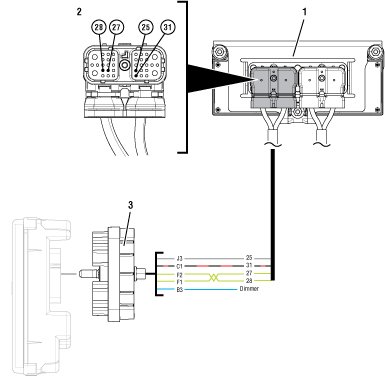 |
1. Transmission Electronic Control Unit (TECU) 2. 38-Way Vehicle Harness Connector 3. 30-Way Eaton Push Button Shift Control Device (PBSC) Connector |
 |
Fault Code 15 Troubleshooting
Record the transmission fault codes, FMIs, occurrences, and timestamps from the Service Activity Report created during the Diagnostic Procedure.
If Fault Code 16 is Active, troubleshoot per Fault Code Isolation Procedure Index.
If Fault Code 15 is Active, Go to Step D
If Fault Codes 16 or 19 are Inactive and Fault Code 15 sets Inactive, troubleshoot Fault Code 16 per Fault Code Isolation Procedure Index.
If Fault Code 15 is Inactive and neither Fault Code 16 nor 19 is set, Go to Step B
Key off.
NoticeIf vehicle is equipped with a Bulkhead Connection, disconnect Bulkhead Connector. Inspect connector for corrosion, loose terminals and bent or spread pins.
Wiggle wiring connections to the Bulkhead Connector to verify the pins are not loose and are secure within the connector.
Reconnect Bulkhead Connector.
If no Bulkhead Connection is present, Go to Step C
If damage or looseness is found, refer to OEM guidelines for repair or replacement of Bulkhead Connection. Go to Step V
If no damage is found, Go to Step C
Set parking brake and chock wheels.
Place transmission in PD Mode. See more about Product Diagnostic (PD) Mode.
Note: Transmission does not enter PD Mode when Active fault codes exist.

Wiggle wiring and connections from the Push Button Shift Controller (PBSC) to the batteries. Look for signs of pinched or chafed wiring. Verify all connections are clean and tight.
Wiggle wiring and connections of the High Integrity Link (HIL) between the 30-Way PBSC Connector and the 38-Way Vehicle Harness Connector at the TECU. Look for signs of pinched or chafed wiring. Verify all connections are clean and tight.
Exit PD Mode by powering down.
Notice
If any fault code became Active while wiggling the PBSC power supply, refer to OEM guidelines for repair or replacement of the PBSC power supply harness. Go to Step V
If any fault code became Active while wiggling the HIL, refer to OEM guidelines for repair or replacement of the HIL wiring. Go to Step V
If no fault codes became Active, refer to OEM guidelines for repair or replacement of HIL wiring between the PBSC and TECU. Go to Step V
Key off.
NoticeIf vehicle is equipped with a Bulkhead Connection, disconnect Bulkhead Connector. Inspect connector for corrosion, loose terminals and bent or spread pins.
Wiggle wiring connections to the Bulkhead Connector to verify the pins are not loose and are secure within the connector.
Reconnect Bulkhead Connector.
If no Bulkhead Connection is present, Go to Step E
If damage or looseness is found, refer to OEM guidelines for repair or replacement of Bulkhead Connection. Go to Step V
If no damage is found, Go to Step E
Key off.
Disconnect 30-Way PBSC Connector.
Inspect 30-Way for loose terminals, corrosion and bent or spread pins.
If damage is found, refer to OEM guidelines for repair or replacement of 30-Way Connector and harness.
If no damage is found, Go to Step F
Key on with engine off.
Measure voltage between 30-Way Pin C1 and Pin J3. Record reading(s) in table.
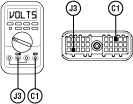
Compare reading(s) in table.
If readings are in range, Go to Step I
If readings are out of range, Go to Step G
| Pins | Range | Reading(s) |
|---|---|---|
| C1 to J3 | Within 0.6 V of battery voltage |
Key off.
Disconnect 38-Way Vehicle Harness Connector from TECU.
Inspect 38-Way for loose terminals, corrosion and bent or spread pins.
Measure resistance between 38-Way Vehicle Harness Connector Pin 31 and 30-Way PBSC Connector Pin C1. Record reading(s) in table.
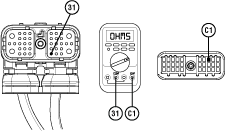
Measure resistance between 38-Way Vehicle Harness Connector Pin 25 and 30-Way PBSC Connector Pin J3. Record reading(s) in table.
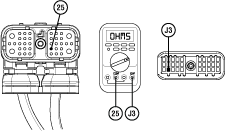
Compare reading(s) in table.
If readings are in range, Go to Step H
If readings are out of range, refer to OEM guidelines for repair or replacement of harness between TECU and PBSC. Go to Step V
| Pins | Range | Reading(s) |
|---|---|---|
| 31 to C1 | 0.0–0.3 ohms | |
| 25 to J3 | 0.0–0.3 ohms |
Key off.
Disconnect 38-Way Vehicle Harness Connector from TECU.
Inspect connector body for corrosion, damage, loose, spread or bent terminals.
Measure voltage between 38-Way Connector Pin 38 and Pin 36. Record reading.
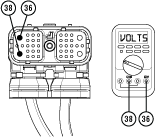
Compare voltage to specified range in table.
If readings are in range, replace Transmission Electronic Control Unit (TECU). Go to Step V
If readings are out of range, refer to OEM guidelines for repair or replacement of Vehicle Power Supply Harness. Go to Step V
| Pins | Range | Reading(s) |
|---|---|---|
| 38 to 36 | Within 1.2 V of Battery Voltage (Step A) |
Key off.
NoticeMeasure resistance between 30-Way Connector Pin F1 and Pin F2. Record reading(s) in table.
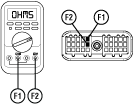
Compare reading(s) in table.
If readings are in range, Go to Step J
If readings are out of range, refer to OEM guidelines for repair or replacement of High Integrity Link (HIL) between the PBSC and TECU. Go to Step V
| Pins | Range | Reading(s) |
|---|---|---|
| F1 to F2 | 50–70 ohms |
Key off.
Disconnect 38-Way Vehicle Harness Connector from TECU.
Inspect 38-Way for loose terminals, corrosion and bent or spread pins.
If damage is found, refer to OEM guidelines for repair or replacement of 38-Way Connector and harness. Go to Step V
If no damage is found and the connector is not loose, Go to Step K
Key off.
Measure resistance between 38-Way Vehicle Harness Connector Pin 28 and 30-Way PBSC Connector Pin F1. Record reading(s) in table.
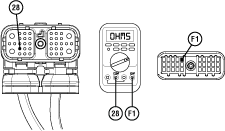
Compare reading(s) in table.
If readings are in range, Go to Step L
If readings are out of range, refer to OEM guidelines for repair or replacement of High Integrity Link (HIL) between the PBSC and TECU. Go to Step V
| Pins | Range | Reading(s) |
|---|---|---|
| 28 to F1 | 0.0–0.6 ohms |
Key off.
Measure resistance between 38-Way Vehicle Harness Connector Pin 27 and 30-Way PBSC Connector Pin F2. Record reading(s) in table.
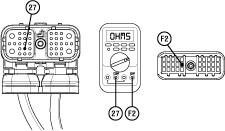
Compare reading(s) in table.
If readings are out of range, refer to OEM guidelines for repair or replacement of High Integrity Link (HIL) between the PBSC and TECU. Go to Step V
If readings are in range, replace Eaton Push Button Shift Control Device (PBSC). Go to Step V
| Pins | Range | Reading(s) |
|---|---|---|
| 27 to F2 | 0.0–0.6 ohms |
Key off.
Reconnect all connectors and verify that all components are properly installed.
Key on with engine off.
Clear fault codes using ServiceRanger.
Drive vehicle and attempt to reset the code or duplicate the previous complaint.
Check for fault codes using ServiceRanger.
If no fault codes set Active and vehicle operates properly, test complete.
If Fault Code 15 sets Active during test drive, refer to Contact Information and contact Eaton for further diagnostics.
If a fault code other than 15 sets Active, troubleshoot per Fault Code Isolation Procedure Index.